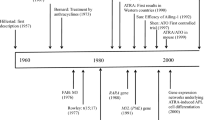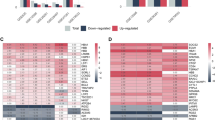Abstract
Objective
This study was to observe the levels of Ets2 mRNA expression in leukemia patients and investigate the effect of small interfering RNA (siRNA) targeting Ets2 gene on sensibility of human acute monocytic leukemic cell line SHI-1 cells to etoposide (VP-16). SHI-1 cells to etoposide (VP-16).
Methods
Ets2 mRNA levels were determined by reverse transcription polymerase chain reaction (RT-PCR). reaction (RT-PCR). After the transfection of Ets2 siRNA to SHI-1 cells by electroporation method, qRT-PCR was used to detect Ets2 gene expression in these cells; VP-16-induced apoptosis was investigated by Annexin V-FITC/PI. Ets2 gene expression in these cells; VP-16-induced apoptosis was investigated by Annexin V-FITC/PI.
Results
Ets2 mRNA was detectable in SHI-cells. was detectable in SHI-cells. The Ets2 expression rate was respectively 10% in 5 healthy volunteers, 60% in 5 acute lymphocytic leukemia (ALL) patients, 73. leukemia (ALL) patients, 73. 68% in 19 acute nonlymphocytic leukemia (ANLL) patients and 100% in 4 chronic myeloid leukemia (CML) patients. leukemia (CML) patients. The expression levels of Ets2 mRNA were significantly higher in leukemia patients compared with healthy volunteers. healthy volunteers. It also showed that siRNA targeting Ets2 gene resulted in substantial loss of Ets2 mRNA of SHI-1 cells compared to the control groups. compared to the control groups. Downregulation of Ets2 gene expression increased SHI-1 cells apoptosis and VP-16-induced apoptosis of SHI-1 cells. apoptosis of SHI-1 cells.
Conclusion
The high-level expression of Ets2 transcription factor in leukemia cells were connected with proliferation and anti-apoptosis of leukemia cells. with proliferation and anti-apoptosis of leukemia cells. SiRNA mediated Ets2 gene silencing induced cell apoptosis and enhanced in vitro sensitivity to chemotherapy (VP-16) of SHI-1 cells. in vitro sensitivity to chemotherapy (VP-16) of SHI-1 cells. It speculated the high-level expression of Ets2 may actually be an unfavorable determinant of chemotherapy sensitivity in leukemia. be an unfavorable determinant of chemotherapy sensitivity in leukemia.
Similar content being viewed by others
References
Yordy JS, Muise-Helmericks RC. Signal transduction and the Ets family of transcription factors. Oncogene, 2000, 19: 6503–6513.
de Nigris F, Mega T, Berger N, et al. Induction of ETS1 and ETS2 transcription factors is required for thyroid cell transformation. Cancer Res, 2001, 61: 2267–2275.
Li X, Lu JY, Zhao LQ, et al. Overexpression of ETS2 in human esophageal squamous cell carcinoma. World J Gastroenterol, 2003, 9: 205–208.
Carbone GM, Napoli S, Valentini A, et al. Triplex DNA-mediated downregulation of Ets2 expression results in growth inhibition and apoptosis in human prostate cancer cells. Nucleic Acids Res, 2004, 32: 4358–4367.
Foos G, Hauser CA. Altered Ets transcription factor activity in prostate tumor cells inhibits anchorage-independent growth, survival and invasiveness. Oncogene, 2000, 19: 5507–5516.
Buggy Y, Maguire TM, McDermott E, et al. Ets2 transcription factor in normal and neoplastic human breast tissue. Eur J Cancer, 2006, 42: 485–491.
Zabuawala T, Taffany DA, Sharma SM, et al. An ets2-driven transcriptional program in tumor-associated macrophages promotes tumor metastasis. Cancer, Res, 2010, 70: 1323–1333.
Dwyer JM, Liu JP. Ets2 transcription factor, telomerase activity and breast cancer. Clin Exp Pharmacol Physiol, 2010, 37: 83–87.
Santoro A, Maggio A, Carbone P, et al. Amplification of ETS2 oncogene in acute nonlymphoblastic leukemia with t (6;21;18). Cancer Genet Cytogenet, 1992, 58: 71–75.
Ge Y, LaFiura KM, Dombkowski AA, et al. The role of the proto-oncogene ETS2 in acute megakaryocytic leukemia biology and therapy. Leukemia, 2008, 22: 521–529.
Zeller B, Gustafsson G, Forestier E, et al. Acute leukaemia in children with Down syndrome: a population-based Nordic study. Br J Haematol, 2005, 128: 797–804.
Stankiewicz MJ, Crispino JD. ETS2 and ERG promote megakaryopoiesis and synergize with alterations in GATA-1 to immortalize hematopoietic progenitor cells. Blood, 2009, 113: 3337–3347.
Baldus CD, Liyanarachchi S, Mrózek K, et al. Acute myeloid leukemia with complex karyotypes and abnormal chromosome 21: Amplification discloses overexpression of APP, ETS2, and ERG genes. Proc Natl Acad Sci U S A, 2004, 101: 3915–3920.
Elbashir SM, Harborth J, Lendeckel W, et al. Duplexes of 21-nucleotide RNAs mediate RNA interference in cultured mammalian cells. Nature, 2001, 411: 494–498.
Wiese M, Castiglione K, Hensel M, et al. Small interfering RNA (siRNA) delivery into murine bone marrow-derived macrophages by electroporation. J Immunol Methods, 2010, 353: 102–110.
Chen S, Xue Y, Zhang X, et al. A new human acute monocytic leukemia cell line SHI-1 with t(6;11)(q27;q23), p53 gene alterations and high tumorigenicity in nude mice. Haematologica, 2005, 90: 766–775.
Tomonaga M. New classification of leukemia. Rinsho Byori, 2001 Suppl 15, 3: 45–53.
Maroulakou IG, Bowe DB. Expression and function of Ets transcription factors in mammalian development: a regulatory network. Oncogene, 2000, 19: 6432–6442.
Jin DI, Jameson SB, Reddy MA, et al. Alterations in differentiation and behavior of monocytic phagocytes in transgenic mice that express dominant suppressors of ras signaling. Mol Cell Biol, 1995, 15: 693–703.
Boulukos KE, Pognonec P, Sariban E, et al. Rapid and transient expression of Ets2 in mature macrophages following stimulation with cMGF, LPS, and PKC activators. Genes Dev, 1990, 4: 401–409.
Sevilla L, Zaldumbide A, Carlotti F, et al. Bcl-XL expression correlates with primary macrophage differentiation, activation of functional competence, and survival and results from synergistic transcriptional activation by Ets2 and PU.1. J Biol Chem, 2001, 276: 17800–17807.
Sevilla L, Aperlo C, Dulic V, et al. The Ets2 transcription factor Inhibits apoptosis induced by colony-stimulating factor-1 deprivation of macrophages through a Bcl-xL -dependent mechanism. Mol Cell Biol, 1999, 19: 2624–2634.
Author information
Authors and Affiliations
Corresponding author
Additional information
Supported by a grant from the Natural Science Foundation of Hubei Province (No. 2009CDB416).
Rights and permissions
About this article
Cite this article
Huang, C., Wang, L., Li, C. et al. Effect of siRNA targeting Ets2 gene on chemosensitization of human acute monocytic leukemic cell line SHI-1. Chin. -Ger. J. Clin. Oncol. 10, 726–729 (2011). https://doi.org/10.1007/s10330-011-0864-x
Received:
Revised:
Accepted:
Published:
Issue Date:
DOI: https://doi.org/10.1007/s10330-011-0864-x




